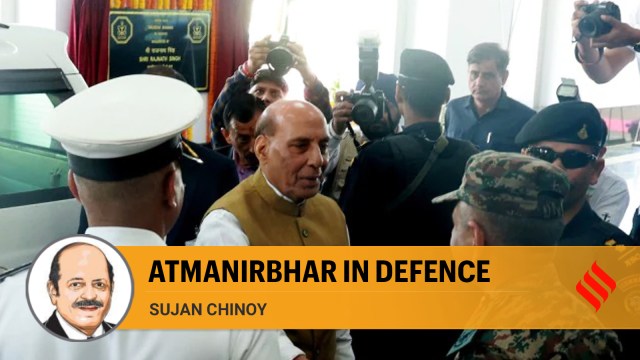- India
- International
India’s atmanirbhar defence sector
The transformation underway in the defence industrial complex has set the stage for multiple stakeholders to rally and promote domestic technological innovation
 Defence Minister Rajnath Singh in Delhi. (Express photo by Amit Mehra)
Defence Minister Rajnath Singh in Delhi. (Express photo by Amit Mehra)India’s defence ecosystem has undergone transformations in several key areas in recent years. Key institutional and policy changes have spurred defence indigenisation, domestic capital procurement and defence exports.
In an era of uncertainty, the goals of Atmanirbhar Bharat (self-reliant India) and Make In India would mitigate risks on account of disruption or manipulation of critical supply chains — the kind of challenges that have constrained Ukraine in its conflict with Russia.
The Defence Acquisition Procedure (DAP) 2020 prescribed 50 per cent indigenous content (IC) in procurement contracts. To encourage foreign original equipment manufacturers (OEMs) to set up maintenance and manufacturing facilities in India, a new procurement category — Buy (Global-Manufacture in India) — has been introduced. This will enable ab initio indigenisation of spare parts. The Union Ministry of Defence (MoD) has released several “Positive Indigenisation Lists” that mention items that must be procured only from domestic sources. Nearly 5,000 items currently imported by the Defence Public Sector Units (DPSUs) and the three Services figure in this list.
The Srijan Indigenisation Portal was launched in August 2020. Over 34,000 items currently being imported have been uploaded on the portal — nearly a third
of them are already in the process of being indigenised.
Two defence industrial corridors have been established in Tamil Nadu and Uttar Pradesh. These have attracted investments worth Rs 7,000 crore. MoUs for a cumulative potential investments worth over Rs 20,000 crore have also been concluded. In November 2023, the Swedish arms major SAAB announced the first 100 per cent FDI project to manufacture the Carl Gustav M4 rocket system.

There has been laudable progress in building naval platforms. The INS Vikrant aircraft carrier, dedicated to the nation by Prime Minister Narendra Modi in September 2022, is the largest warship built in India’s maritime history. It is spawning new technological capabilities across the Indian industry, including SMEs and MSMEs.
The Indian Navy’s Warship Design Bureau has launched Project 17A frigates. The INS Vindhyagiri, launched in August 2023, is the latest example of this. There is equal focus on missiles, long-range artillery guns, multi-barrel rocket launchers and tanks, besides advanced radars, sensors and electronic capabilities.
The government recently constituted a committee to undertake a holistic review of the functioning of the Defence Research and Development Organisation (DRDO). Building “fit to purpose” domestic capabilities in defence R&D and innovation, commensurate with the challenges of the 21st century, remains the agency’s guiding principle.
The Centre has stipulated that a significant portion of the defence capital procurement budget should be diverted to the domestic defence industry. Since 2020-21, the capital acquisition budget for domestic procurement has risen from around 40 per cent of the total capital procurement budget (Rs 52,000 crore) to 75 per cent (Rs 99,223 crore) in 2023-24. Moreover, since 2022-23, 25 per cent of this domestic capital procurement budget has been earmarked for purchases from the private sector.
As a result of these initiatives, the value of India’s defence production crossed the Rs 1,00,000 crore mark for the first time in financial year 2022-23 to touch Rs 1,08,684 crore. Defence Public Sector Undertakings accounted for nearly 75 per cent of this.
Significantly, private sector companies accounted for Rs 21,083 crore, about 20 per cent of the total with joint ventures accounting for the rest. The defence production target for 2023-24 is Rs 1,35,000 crore and India expects the value of its defence production to reach Rs 1,75,000 crore by 2025.
The Innovations for Defence Excellence (iDEX) initiative, launched in 2018, aims to involve industry, including MSMEs, start-ups, individual innovators, R&D institutes and academia.
The iDEX Prime framework under iDEX was launched in 2022 to support start-ups with grants-in-aid up to Rs 10 crore to enable the development of high-end solutions. Funding under the Technology Development Fund (TDF) scheme has been enhanced from Rs 10 crore to Rs 50 crore per project. The DRDO has launched the Dare to Dream Innovation contest to support start-ups and innovation. A quarter of the defence R&D budget in 2023-24 has also been earmarked for academia and private industry.
In 2019, the Stockholm International Peace Research Institute (SIPRI) placed India among the top 25 arms exporters (at 23rd position) for the first time. India has set a defence exports target of Rs 35,000 crore by 2025.
Equally path-breaking is PM Modi’s consistent effort to craft policies that provide equal career opportunities to women in the armed forces. This will help the forces in tapping a large pool of latent talent.
The government’s Nari Shakti initiative has played a major role in the transformation of the nation, especially the armed forces. Sainik Schools, which have long served as grassroots institutions for recruitment in the armed forces, are no longer a male bastion. The doors of the National Defence Academy have also been thrown open to women. The number of women officers has risen sharply in recent years.
The goal of a Viksit Bharat (developed India) by 2047 requires the defence sector to be more resilient and self-reliant. The transformation underway in the defence industrial complex has set the stage for multiple stakeholders to rally and promote domestic technological innovation while cementing strategic partnerships around the world. The day is not far when India will become an integral part of the global defence value chains.
The writer is director general of the Manohar Parrikar Institute for Defence Studies and Analyses. Views expressed are personal
EXPRESS OPINION
More Explained
Apr 04: Latest News
- 01
- 02
- 03
- 04
- 05
































